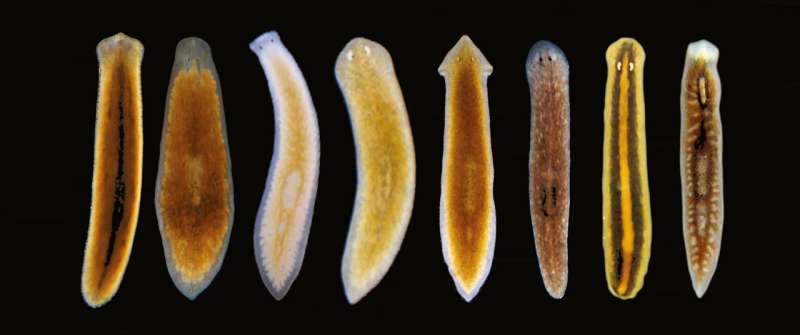This article has been reviewed according to Science X's editorial process and policies. Editors have highlighted the following attributes while ensuring the content's credibility:
fact-checked
peer-reviewed publication
trusted source
proofread
Why some worms regenerate and others do not

Why are so few species able to regenerate damaged or missing body parts, even though regeneration might seem an obvious survival advantage? Researchers at the Max Planck Institute (MPI) for Multidisciplinary Sciences in Göttingen, Germany, and colleagues have now found a possible explanation in planarian flatworms. Analyzing head regeneration abilities in a large collection of planarian species, they found that these capacities vary greatly and depend on how the different species reproduce.
The multi-headed monster Hydra was so terrifying, because it would re-grow two new heads for every head that was cut off. While the Hydra is a myth, animals that can regenerate body parts also exist in the real world. In fact, some species of planarians are true masters of regeneration. Even when cut into many small pieces, each piece regenerates back into a complete worm. Other planarian species, however, cannot regenerate missing or damaged organs or tissues.
"Regeneration seems to be the exception in the animal kingdom, even though it should be a great advantage for survival. We are interested in why so many animals, including humans, lack this ability," explains Jochen Rink, director at the MPI for Multidisciplinary Sciences.
The world's largest planarian collection
With more than 40 species, Rink's department maintains the world's largest planarian collection. "Thanks to our collection, we can systematically compare the regenerative capacities of species under standardized laboratory conditions," the cell biologist says. The small invertebrates in Rink's group come from all over the world, can be found in ponds, streams, on land, or even in the sea, and prey on the smaller inhabitants of their various ecological niches.
In the largest comparative study of planarians to date, also involving Christoph Bleidorn and Felix Thalén of the Johann-Friedrich-Blumenbach Institute for Zoology and Anthropology at the University of Göttingen and colleagues from Germany, Australia, Austria, Brazil, and Spain, the researchers investigated the ability of 36 planarian species to regenerate their heads.
"We found three groups," says Miquel Vila-Farré, first author of the study published in the journal Nature Ecology & Evolution. "The first group has little or no ability to regenerate, the second has limited ability to replace body parts, and the third has reliable head regeneration. These differences make the evolutionary history of head regeneration in planarians particularly interesting."
Gain and loss of head regeneration in planarians
The researchers then reconstructed at what point in evolution the different species developed or lost their ability to regenerate their heads. Using phylogenetic tree analyses on basis of genetic markers, they found that the evolution of head regeneration was unexpectedly dynamic.
Vila-Farré says, "The ability to regrow organs and tissues evolved several times independently in different planarians, and some species even lost it over time." However, the limited or absent regenerative capacity seems to be based on the same molecular mechanism.
Rink's team already knew from previous experiments that molecular signals have a significant influence on the ability to regenerate. The Max Planck director explains, "In planarian regeneration, a specific signaling pathway acts like a molecular switch."
If the so-called Wnt signaling pathway is switched on, the regeneration of the tail is initiated. When the switch is turned off, a head always forms. When the scientists inhibited the Wnt pathway in different planarian species, their ability to regenerate improved. Even species with limited regeneration, such as the Australian species Cura pinguis, were able to form new head-like structures.
Regeneration for reproduction
The researchers showed that Wnt signaling also plays an important role in the formation and maintenance of the reproductive system. The team studied strains of the planarian species Schmidtea mediterranea that reproduce either asexually or sexually.
"Planarians that reproduce asexually split into two parts that both regenerate. These species rely on regeneration to reproduce," explains Vila-Farré. In contrast, species with limited regenerative capacity reproduce almost exclusively sexually. This means that they lay eggs and do not need to regenerate body parts to reproduce. This is in line with the team's findings: the Wnt signaling pathway was much more active in the sexual strain of Schmidtea mediterranea.
The scientists hypothesize that higher levels of Wnt signaling promote the formation of testes and egg yolks, but at the expense of regenerative capacity, as this depends on the inhibition of the Wnt pathway.
"Interactions between the Wnt signaling pathway and the reproductive system may therefore determine the gain or loss of regenerative capacity in different planarian species," says Rink.
"We suspect that the regenerative capacity in planarians has evolved not for the purpose of 'repairing' wounds, but for the purpose of asexual reproduction through division. This provides a possible explanation for why planarians with and without the ability to regenerate have evolved in nature."
More information: Miquel Vila-Farré et al, Evolutionary dynamics of whole-body regeneration across planarian flatworms, Nature Ecology & Evolution (2023). DOI: 10.1038/s41559-023-02221-7
Journal information: Nature Ecology & Evolution
Provided by Max Planck Society





















